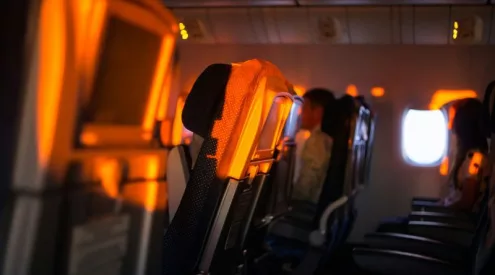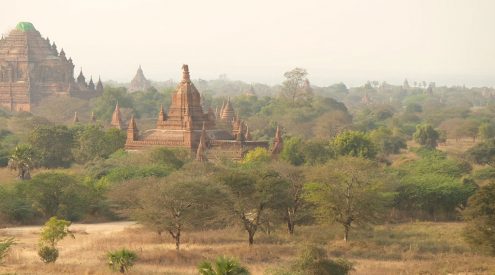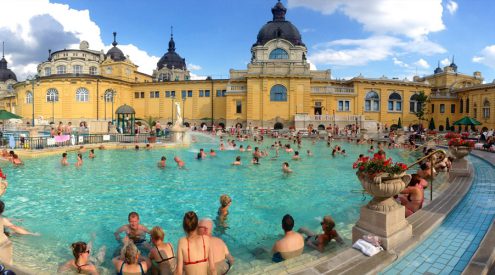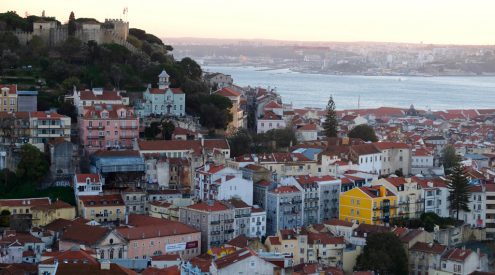I half woke in a capsule of ethereal blue light. It was freezing and utterly silent. Just then, an angel with flaxen pigtails leant over me. ‘This is your wake-up call,’ she said with a lilting Swedish accent. ‘Here’s a cup of warm lingonberry juice. No rush, get up when you’re ready and come have a sauna.’
Then she was gone. Had I dreamed her? Friends back home had joked that guests were issued with a buxom Swedish blonde each evening before going to sleep in their ice beds. Unfortunately, this is not the case. But I hadn’t dreamed the wake-up lass … and there I was, in the Arctic, lying on reindeer pelts in an ice room, ready to face a day in the snowy wilderness.

Into the frozen waste
Getting to Sweden’s Ice Hotel is part of the magic. From Stockholm, it’s an hour-anda- half flight north, up the Scandinavian peninsula, to the mining town of Kiruna in the heart of Lapland. The snow was piled high on either side of the runway as we taxied to the terminal building. A 20-minute minibus ride brought us to the village of Jukkasjärvi, home to the Ice Hotel.
After check in, guests are given a tour of the grounds and facilities. The hotel is divided into warm and cold accommodation. Most guests opt to spend their first night in an ice room, moving to warm accommodation for the rest of their stay.
You’re briefed on how to sleep in -5° Celsius and advised to leave your belongings in a locker in the main building, lest they freeze solid. Next, you’re issued with snow overalls, double gloves and boots for the duration of your stay. Ice rooms are purely for sleeping in and are open to the public during the day. Some are decorated with remarkable works of art – sculptures, ornate beds and furniture – all carved from ice.
Our party of new arrivals was led from the living quarters to the Ice Bar. Here, even the glasses are made of ice and the pretty, blonde barmaids have to wear fur hats and thick gloves. It isn’t exactly a room to hang out in, more a place to get your vodka fix, take a few photos and move on.
An adjacent building housed the chapel, a popular wedding venue. Everything from pews to altar was made of ice. It had a Gothic interior, like something out of Lord of the Rings, and the ice-filtered blue light added a suitably holy glow.
A bride and groom were just emerging when we arrived. She looked like a snow princess and the priestess wore a long, white fur cloak. Confetti rice was thrown, snow flakes drifted down, the odd tear of joy was hastily wiped away.
Sleeping in -5° Celsius
On my first evening, I dined at the Old Homestead, the more affordable and cosy of the hotel’s two restaurants. It’s housed in an 18th-century log cabin which once served as a school for Sami (the indigenous people of Lapland) children. One drawback is that it’s a kilometre walk from the hotel and things can get a tad chilly if you’re not wearing full snow kit. Wanting to look vaguely dapper for dinner, I was in ‘South African’ clothes.
Hurrying to the restaurant, watching the ground lest I take a tumble on the treacherous ice, I happened to glance skyward. The sight that graced the horizon brought me to an abrupt halt. Five fingers of eerie green light, like a great hand, reached up to fill the heavens. Aurora Borealis, the Northern Lights. The hand arced overhead, becoming paler and more ephemeral as it grew. I was transfixed. My imagination supplied a haunting soundtrack – a version of the Sami chanting I’d heard at the hotel – as my percussion teeth began to chatter. I stared and stared until hyperthermia set in, then sprinted for dinner, over the moon at my sighting and not caring about the slippery ice.
Back in the hotel later, I joined a posse of guests preparing for bed. We donned thermal underwear and woolly hats, collected our down sleeping bags and set off for the rooms wearing boots and jackets over the top of our negligees. It is, admittedly, a bit daunting going to bed in a fridge. I rolled out my sleeping bag on top of the reindeer pelts and dived in. The idea is that you pull the drawstring tight so that only your nose and eyes remain exposed. It’s a surprisingly snug sleeping experience.

Out and about in snowland
After transferring to a warm room on the second morning, I set off to sample the activities on offer. Two of the highlights are dogsledding and snowmobiling.
The huskies arrived in a van and were hitched up to the sled. The excitement grew with each minute until the dogs were howling, yipping and barking at the bearded driver, impatient to be off. Some of the pairs leapt vertically or got into snapping skirmishes, so anxious were they to fly. At last, the snow anchor was released, the driver gave a shout, and we hurtled across the snow, the sled’s runners swishing as the speed increased. Soon the hotel was just a tiny bump in the sea of white.
There are a number of snowmobiling activities on offer. I opted for the Northern Lights tour. The Sami guide met our group at sunset and took us through snowmobile etiquette. Then, it was into the wilderness, our chariots hurtling upstream along the frozen river.
Darkness fell and on we raced through pine forests and whited valleys. The clouds were low, so no chance of Aurora Borealis, but the ride was thrilling. We drew up at a hexagonal Sami hut where our guide cooked a hearty meal of reindeer goulash and blueberry cake, washed down with lingonberry juice. He spun stories of his forefathers, Lapland ghosts and strange yeti-like men who wandered the land clad only in reindeer skins.
We sat there, cosy in the candlelight, deep in the icy wilderness, listening to tales of the Sami dead, reincarnated as the spirits of the Northern Lights. And I marvelled at this beautiful, alien, Arctic world I’d been privileged to witness. Just then, my little apartment in Cape Town seemed a very, very long way away.

Ice Hotel travel tips
Dressing for the cold
Being properly clad for the Arctic is essential. Dress in multiple layers and avoid cotton clothing, as cotton binds moisture and thus cools rather than warms. Although the Ice Hotel supplies guests with overalls and boots, make sure you have thermal underwear, woolly hat, gloves, scarf, thick socks and waterproof shoes. Oh, and don’t use water-based moisturisers on your face as they can cause frostbite.
How to build with ice
The harvesting of 4 000 tonnes of ice (using chainsaws) from the nearby Torne River starts in March. The enormous ice blocks are kept in cold storage through the summer months and building begins in November. Ice blocks and ‘snice’ (a mixture of snow and ice) are used to fashion the structures. Some are constructed around metal frames which are then removed. Dozens of artists arrive from across the globe to carve the ice interiors; each year the designs are entirely different. The hotel is completed by the end of December. With the onset of warm weather in May, the structure melts back into the Torne River and the cycle is repeated.
Getting to Lapland
From South Africa, you should fly to one of the big European hubs such as London, Paris or Zürich and connect to Stockholm’s Arlanda Airport. Then transfer to a flight to Kiruna on SAS (Scandinavian Airlines). Domestic return flights start from around R2 000. www.flysas.com.
The Ice Hotel will arrange your transfer (SEK150 or R185 a person) from Kiruna Airport to the hotel.
What the Ice Hotel costs
The Ice Hotel is a member of Mantis, a collection of award-winning, privately owned, five-star properties around the world, the brainchild of Adrian Gardiner (www.mantiscollection.com). The hotel is open from December to mid-April. Guests usually spend their first night in an ice room, then move to accommodation in the warm part of the hotel. Basic, cold accommodation rates start from SEK625 (R770) a person a night sharing in low season and from SEK1 025 (R1 263) in high season. Basic, warm accommodation starts from SEK575 (R709) in the low season and from SEK748 (R922) in high season. Part of the hotel opens for the summer from early June to late August; room rates start from SEK665 (R820). Tel +46-980-6-6840, email [email protected], www.icehotel.com.
Meals at the Ice Hotel
The Ice Hotel has two restaurants. Both serve good international cuisine and fine local fare, such as reindeer steak. However, meals are pricey (from R350 a person) and there are no other options nearby (other than a supermarket).
Activities at the Ice Hotel
The hotel arranges a host of daily activities for guests. These are expensive, but well worth the cash outlay. Prices per person range from SEK695 (R857) for ice-sculpting classes to SEK25 500 (R31 500) for an epic, five-day snowmobile expedition to the Arctic Ocean. In between, there’s an array of options, including dog- or reindeer-sledding, various snowmobile excursions, safaris to see moose and Sami cultural tours.
During its midsummer season, the Ice Hotel hosts activities such as hiking, canoeing, white-water rafting and fishing, which draw guests during the time of the ‘midnight sun’.

Affordable Lapland
If the Ice Hotel looks too pricey, you could try one of the more affordable options in Kiruna. At the three-star Camp Ripan, most guests come to explore the wilderness. Activities include cross-country and downhill skiing, ice fishing, snowmobiling and dogsledding. There’s a children’s playground, saunas and, in summer, a heated outdoor pool. Summer activities also include moose safaris by boat, rafting on the Kalix River and horse riding.
Accommodation is in cosy wooden cabins (which sleep four); half of them are equipped for self-catering. The cuisine is great with an emphasis on slow food using local ingredients. Chalets are from SEK598 (R737) a person sharing in the low season and SEK798 (R983) in high season. Enquire about special offers and spending a night in an igloo. Tel +46-980-6-3000, email [email protected], www.ripan.se.
Getaway International

This article is featured in the summer 2012 edition of Getaway International, which is on sale now for R39,95 at selected Pick ‘n Pay, Exclusive Books, CNA, Spar and Woolworths stores across South Africa. You can also buy the digital version of the magazine for R20 here.
This exciting issue covers a first-timer’s trip to magical, chaotic India, an adventurous 4×4 expedition through the ‘Stan’ countries, 48 hours in Dubai, the best of Buenos Aires, houseboating in Africa, stories on Oman and Switzerland, and more.
For more on the summer issue of Getaway International, click here.

















